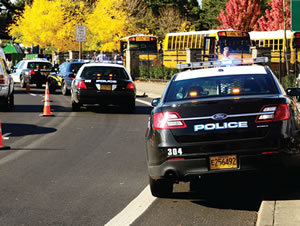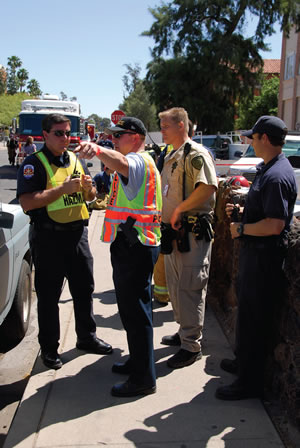Innocent Targets

PHOTO © TFOXFOTO/SHUTTERSTOCK.COM
The attacker entered the school with a duffle bag containing more
than 90 pounds of weapons. He had
a semi-automatic rifle, a pump action
shotgun, a semi-automatic pistol, an
improvised explosive device and precut
paper sheets and tape to cover
classroom windows to prevent police
from seeing inside the room. He also
had wire to bind hostage’s ankles
together in a semi-circle in front of
the classroom door in case police attempted
a tactical rescue. More than
2,000 panicked parents and relatives
rushed to the school when word of the
incident spread. Fortunately, the attacker
was not a terrorist. In fact, he
was a troubled student and the siege
ended peacefully about six hours later.
This attack occurred in a rural Georgia School in the early
1990s. The event proved to be rather challenging for school and law
enforcement officials. Had the attacker been a terrorist, a different
outcome would have been likely and the ensuing panic even more
difficult for school and law enforcement officials to address. While
this incident did not generate national media attention, the same
actions performed by a terrorist would likely result in the types of
intensive and emotive reporting we have seen in the wake of mass
casualty school shootings. Though the chances that any particular
school will experience a terrorist attack are remote, the attack on
any one school, school bus or school event would likely have a negative
impact on every school in America.
INCREASED THREAT LEVEL
Recent terrorist activities in the United States, Europe and other
regions have heightened concerns relating to this highly emotive
and important topic. There are other indications that the general
risk of school-related terrorism in the United States has increased
in the past several years. There have been a number of both averted
and successful attacks by individuals who have been connected
to or inspired by terrorist organizations. There have also been
repeated and earnest cautions about the risks posed by terrorists
from federal government officials including the director of the FBI.
The manner in which our media covers major acts of violence
provides clear indications to individuals or groups who desire to
carry out terrorist attacks that a successful attack on a K-12 school,
school bus or school event would receive intensive media coverage.
Many of the reactions to mass casualty school attacks also
demonstrate that this type of attack would likely generate considerable
fear among Americans. The damage to school safety measures
in this country through alarmist responses since the Sandy Hook
Elementary School attack has been significant. Further emotional
and untested concepts are likely to occur if a school terrorism event
takes place in America.

PHOTO © TFOXFOTO/SHUTTERSTOCK.COM
IMPORTANCE OF ALL-HAZARDS PLANNING
One area where K-12 schools are often vulnerable is the lack of
appropriate all-hazards approaches to school security and emergency
preparedness. For example, our analysts have found that
the majority of the more than 1,000 K-12 schools we have assessed
since the Sandy Hook Elementary School attack do not have a viable
hazardous materials incident protocol and have not conducted any
drills for hazardous materials incidents.
We have found that many K-12 schools have been too heavily
focused on specific types of active shooter incidents, leaving staff
severely unprepared for incidents involving hazardous materials,
edged weapons, explosives and attacks involving the use of fire as a
weapon. This type of focus can also leave schools even more highly
exposed for combination attacks involving the use of firearms in
combination with other types of weapons.
Between 1975 and 2013, at least four combination attacks have
occurred on U.S. K-12 campuses. While none of these attacks has
been related to a terrorist group or ideology, they demonstrate how
easily they could be employed by more sophisticated attackers.
SECURITY PROCEDURES
Fortunately, many of the same school security measures
that can help prevent abductions of children, assaults on staff
and other far more common criminal acts on campus can also
help reduce the risks of terrorism. For example, effective access
control and visitor management systems can make it much more
difficult for an aggressor to enter and conduct pre-attack surveillance
of a school. While a highly motivated and skilled attacker may be able to defeat school security
measures, many planned attacks including
attempts by terrorists have been
thwarted by effective security measures.
Care should be taken to avoid ineffective
“feel good” security measures.
One example of this type of gap would
be entry point weapons screening approaches
that are conducted without appropriate
supportive perimeter security.
While thoughtfully implemented metal
detection can create significant barriers
to an attacker, we have seen examples of
weapons screening checkpoints that are
conducted in such a loose manner that
they can be easily defeated.
In one instance, we noticed that a school
resource officer was using a hand held
metal detector to screen students without
any indications that the metal detector was
working. When we asked to see the unit,
we learned that the batteries were dead
rendering the equipment inoperable.
The use of multiple and supportive
layers of security can significantly increase
the reliability of school security strategies.
The combination of thoughtfully implemented
school security technologies in
combination with good staff development
programs can be particularly effective.

PHOTO © JOHN SARTIN/SHUTTERSTOCK.COM
Peace of Mind. Chances that any school will experience a terrorist attack
are remote, but the attack on any one school, school bus or school event
would likely have a negative impact on every school in America. Many
K-12 schools have been heavily focused on active shooter incidents, leaving
staff severely unprepared for incidents involving hazardous materials,
edged weapons, explosives and attacks involving the use of fire as
a weapon. The majority of U.S. schools do not have a viable hazardous
materials incident protocol and have not conducted any drills for hazardous
materials incidents. Thoughtful, balanced and consistently applied
approaches to school security and emergency preparedness can reduce
the risks associated with school terrorism and help to address much more
common types of school crisis events.
SECURITY AND EMERGENCY
PREPAREDNESS TECHNOLOGY
The school security market has become
highly competitive. Manufacturers
have often improved their product offerings.
This has resulted in more practical
and effective security and emergency
preparedness products. School security
technology solutions have their limits,
but many schools we assessed have
significantly improved the levels of school
security and emergency preparedness by
combining improved technology solutions
with positive human practices. For
example, thousands of sexual predators
have been identified through visitor management
software systems combined with
alert school staff who followed proper
screening procedures. Improved emergency
communications systems can also
help to reduce the number of casualties in
the event of a terrorist attack at a school.
HUMAN FACTORS
Our ability to train school employees
to spot and react to indications that a
person, or group of people, pose a threat
has also improved in recent years. I have
personally been involved with a number
of instances where intelligent and highly
motivated individuals have been stopped
from carrying out planned attacks at
schools and school athletic events. In one
such incident, Officer Kenneth Bronson
of the Bibb County (Ga.) Public School
Police Department was able to prevent
three men from shooting a middle school
student because the officer noticed some
unusual behavioral cues.
Behavioral training can help school
staff detect subtle signs that people pose
a danger. There are also specific training
concepts that can help school staff spot
indicators that someone is carrying a concealed
firearm. This type of training has
helped to avert a number of planned school
shootings over the past 20 years.
The risks of any particular school being
targeted by terrorists are statistically quite
low. However, the fear generated by even a
single attack America could be significant.
Thoughtful, balanced and consistently
applied approaches to school security and
emergency preparedness can reduce the
risks associated with school terrorism while
also helping to address much more common
types of school crisis events. Effective
school security and emergency preparedness
measures can also help to provide the
critical peace of mind that is important to
parents, students and staff.
This article originally appeared in the issue of .